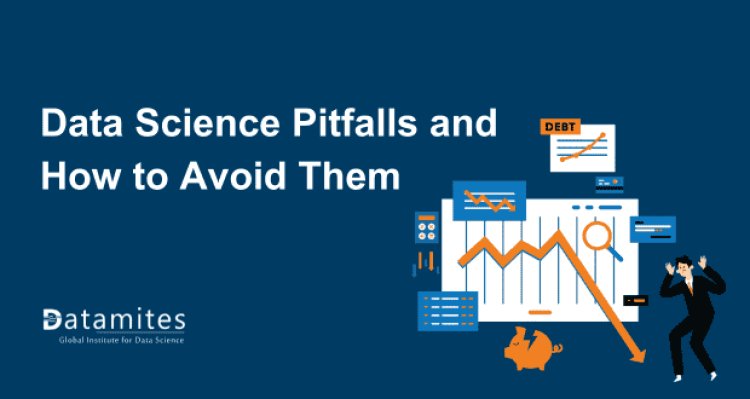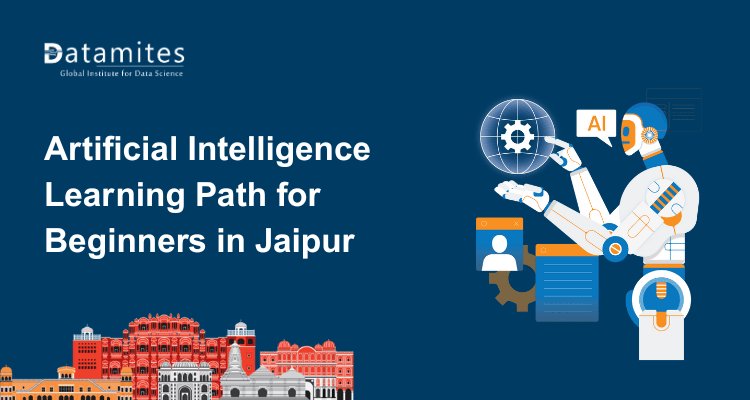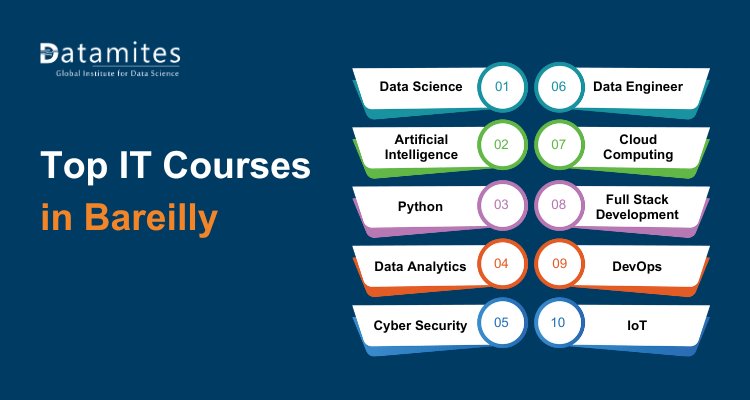Data Science Pitfalls and How to Avoid Them

Did you know that over 85% of data science projects never reach the production stage? These failures often arise from common pitfalls that could have been avoided. This staggering statistic highlights a crucial reality: no matter how much data science expertise one has, understanding potential pitfalls is vital to success.
This blog is designed to help you uncover and avoid the most common pitfalls in data science, whether you’re working on your first project or are an experienced data scientist. If you're investing time in a data science course, data science training, or a data science certification, understanding these pitfalls will amplify your skills and increase the success rate of your projects.
We’ll explore common pitfalls, from poor data quality to the impact of overfitting. You’ll also learn practical strategies to avoid these errors, real-world examples of both successful and failed projects, and actionable advice to make every data science project a success.
Understanding Data Science Pitfalls
Data science pitfalls are common challenges or mistakes that can derail a project. These pitfalls may come in the form of poor data quality, lack of clarity in objectives, overfitting, or failure to communicate findings effectively. Recognizing these pitfalls early on is essential for data scientists to prevent project roadblocks.
Why Identifying Pitfalls Matters
Identifying and addressing pitfalls early is essential because even the most advanced data models cannot fix poor initial foundations. When projects hit these hurdles, organizations lose time, resources, and trust. For anyone working toward a data science certification or undertaking a data science training program, knowing these pitfalls is essential for translating knowledge into impactful results.
Refer these articles:
- How to Transition into a Data Science Career from a Non-Technical Background
- Introduction to Data Visualization in Data Science
- Networking Strategies for Aspiring Data Scientists
Common Data Science Pitfalls
In the fast-evolving field of data science, practitioners face several common pitfalls that can compromise the accuracy, integrity, and utility of their analyses and models. Understanding these pitfalls can help data scientists design better workflows and avoid potential missteps. Here are some of the most common stumbling blocks:
Pitfall 1: Poor Data Quality
A major hurdle in data science is maintaining excellent data quality. Data can be incomplete, outdated, or inaccurate, which directly impacts the validity of insights derived from it.
Consequences:
- Misleading insights: Inaccurate data can drive faulty conclusions, ultimately defeating the goal of data analysis.
- Wasted resources: Time and money spent on analyzing flawed data could yield negligible results.
Examples: A prominent case involved a retail company that relied on outdated sales data for forecasting. The resulting projections misled stakeholders, leading to overproduction of items that were no longer in demand.
Pitfall 2: Lack of Clear Objectives
When data science projects begin without well-defined goals, teams often find themselves lost in the analysis. Ambiguous objectives can lead to unfocused efforts, resulting in irrelevant findings.
Consequences:
- Irrelevant results: Without clear goals, analyses may not address the most pressing business questions.
- Stakeholder dissatisfaction: Stakeholders may become frustrated with outcomes that do not align with their expectations.
Examples: An organization that attempted to analyze customer behavior without specific objectives ended up with a multitude of insights that did not resonate with its marketing strategy, resulting in wasted time and effort.
Pitfall 3: Overfitting Models
Overfitting happens when a model becomes overly intricate, capturing random fluctuations in the data rather than the true underlying patterns. While such models may perform well on training data, they often fail to generalize to new data.
Consequences:
- Inaccurate predictions: Overfitted models can lead to erroneous forecasts when applied in real-world scenarios.
Examples: A financial institution that developed a highly complex predictive model for loan approvals found that it performed poorly in practice, resulting in significant losses due to bad loans.
Pitfall 4: Ignoring Domain Knowledge
Data science practitioners may sometimes overlook the importance of domain expertise. Without incorporating relevant knowledge, analyses can suffer from misinterpretation and flawed assumptions.
Consequences:
- Misinterpretation of data: Without the right context, data scientists risk reaching inaccurate conclusions.
Examples: A healthcare analytics team that analyzed patient data without consulting medical professionals misinterpreted vital trends, leading to misguided treatment protocols.
Pitfall 5: Underestimating the Importance of Communication
Effective communication is vital in data science. Failure to convey findings clearly to stakeholders can hinder project success, as misunderstandings can arise.
Consequences:
- Lack of buy-in: If stakeholders do not understand the insights, they may resist implementing recommendations.
- Misunderstandings: Poor communication can lead to incorrect assumptions about project goals.
Examples: A data science team presented complex visualizations without clear explanations, resulting in confusion among stakeholders and subsequent project delays.
Refer these articles:
- What is Certified Data Scientist Course
- Data Science Career Scope in India
- What would be the Data Science Course Fee in India
Strategies to Avoid Data Science Pitfalls
In any project or initiative, especially complex ones, avoiding common pitfalls is crucial to maintaining momentum, meeting objectives, and achieving long-term success. Here are some effective strategies to navigate potential obstacles:
Ensuring Data Quality
- Best Practices: Implementing data validation techniques and regular data audits can help maintain quality.
- Tools and Technologies: Tools like DataRobot, Pandas, and SQL can assist in data cleaning, validation, and integrity checks.
Setting Clear Objectives
- Frameworks for Goal Setting: Use SMART goals (Specific, Measurable, Achievable, Relevant, and Time-bound) and set clear KPIs to maintain focus.
- Stakeholder Engagement: Engage stakeholders early in the process to align objectives and clarify expectations.
Model Evaluation Techniques
- Best Practices: Cross-validation and regularization methods help ensure models generalize well to new data.
- Tools and Techniques: Scikit-learn, TensorFlow, and Keras offer powerful tools for model assessment and validation.
Leveraging Domain Expertise
- Collaboration Strategies: Working with domain experts can lead to insights that data alone cannot reveal.
- Training and Workshops: Offering opportunities for data scientists to learn from domain experts is invaluable, enhancing understanding and context.
Effective Communication Strategies
- Visualization Techniques: Data visualization tools like Tableau, Power BI, and Matplotlib make data accessible and impactful for stakeholders.
- Regular Updates: Schedule regular updates to keep stakeholders informed, inviting feedback to guide project direction.
Real-World Examples and Case Studies - Data Science Pitfalls
In this section, we will dive into some of the common pitfalls encountered in data science, illustrated through real-world examples and case studies. Understanding these pitfalls is crucial, as they can lead to flawed analyses, biased results, and potentially harmful outcomes when data-driven insights are applied in real-world settings. Here are a few notable examples and cases that underscore the importance of careful, ethical, and methodical practices in data science.
1. Pitfall: Confusing Correlation with Causation
- Case Study: Google Flu Trends
- Description: Google Flu Trends aimed to predict flu outbreaks based on search queries related to flu symptoms. Initially, it showed promise, but eventually, the model failed, overestimating flu cases in the U.S. by significant margins.
- Issue: The project incorrectly assumed that increased searches for flu-related terms directly correlated with flu prevalence. Many other factors, like media coverage, also influenced search behavior, leading to flawed predictions.
- Takeaway: Correlation does not imply causation. Predictive models must carefully account for underlying relationships to avoid over-reliance on correlated data alone.
2. Pitfall: Biased Data Leading to Discriminatory Outcomes
- Case Study: COMPAS Recidivism Algorithm
- Description: The COMPAS tool, designed to evaluate the probability of reoffending in the United States. The justice system was found to demonstrate racial bias. The tool was more likely to flag Black defendants as high risk while underestimating the risk for white defendants.
- Issue: The algorithm was trained on historical data, which contained embedded biases reflecting existing societal prejudices. As a result, the algorithm perpetuated these biases, impacting sentencing decisions.
- Takeaway: Data must be carefully examined for inherent biases, especially in high-stakes applications like criminal justice. Ethical considerations and fairness metrics should be integral to model development.
3. Pitfall: Overfitting Models to Training Data
- Case Study: Netflix Prize
- Description: Netflix hosted a competition offering a $1 million prize to improve its recommendation algorithm. The winning team achieved a 10% improvement on the test dataset, but when applied to real-world data, the improvement did not translate well, and the algorithm was never implemented.
- Issue: The winning model was highly complex and overfitted to the competition dataset, meaning it performed well on specific test data but poorly on new data.
- Takeaway: Overfitting can lead to models that work well on paper but fail in practice. Regularization techniques, cross-validation, and simpler models are often more robust in real-world applications.
4. Pitfall: Misinterpreting Statistical Significance
- Case Study: Drug Trial Results
- Description: A pharmaceutical company conducted a drug trial and found that the drug appeared effective at reducing symptoms based on a p-value of 0.04. However, the sample size was small, and a subsequent, larger trial failed to replicate the results.
- Issue: The initial trial’s results may have been due to chance or insufficient sample size. Relying solely on p-values without considering practical significance or sample size can mislead decision-making.
- Takeaway: Statistical significance does not always mean practical significance. Ensure adequate sample sizes and conduct follow-up studies to validate findings before implementing changes.
Read these articles:
- Data Science Course Fee in Chennai
- Data Science Course Fee in Bangalore
- Data Science Course Fee in Hyderabad
Steering clear of common data science pitfalls is essential for driving successful projects. By enhancing data quality, setting clear objectives, and communicating effectively, you can sidestep common challenges and improve outcomes. Whether pursuing a data science course or managing projects, best practices ensure data science efforts align with real-world results.
DataMites training institute is a leading global training institute dedicated to bridging the skills gap in data science, artificial intelligence, machine learning, and analytics. Accredited by IABAC and NASSCOM FutureSkills, DataMites offers a comprehensive range of courses tailored for both beginners and experienced professionals. Our hands-on approach ensures a perfect blend of theoretical knowledge and practical experience, equipping students with the relevant skills demanded by the job market. Among our offerings are the Certified Data Scientist course, Data Science for Managers, and Python for Data Science. With placement assistance and globally recognized certifications, DataMites is the preferred choice for aspiring data professionals.





